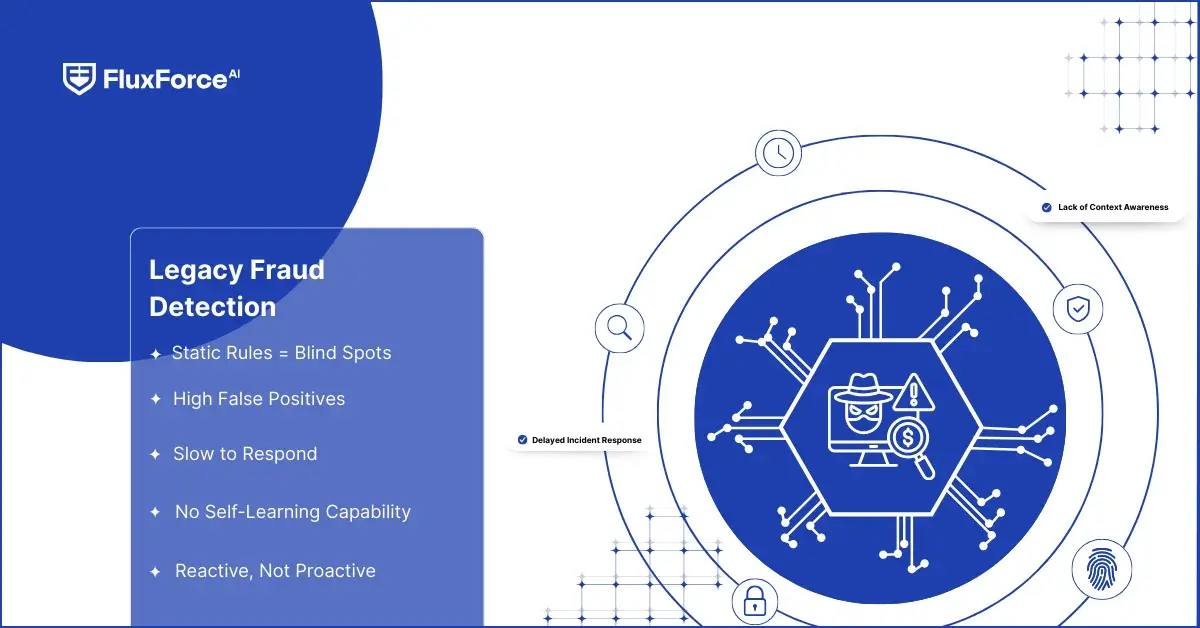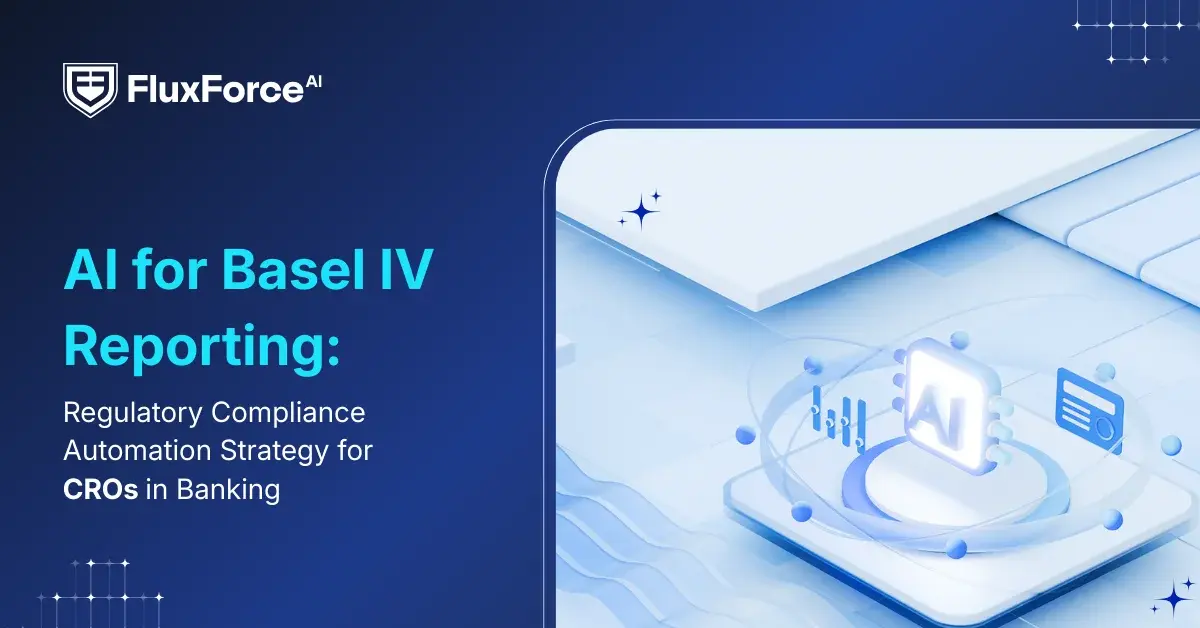Listen To Our Podcast🎧

Introduction
Fraud in Fintech is evolving in a way that even the most advanced legacy fraud monitoring systems often fail to recognize the subtle shifts in attacker behavior across multiple channels.
In 2024, the ACFE Report noted that digital payment fraud in emerging fintech platforms rose 12% year-on-year, despite widespread deployment of traditional AI and rules-based engines.
Ask yourself: how many fraudulent transactions slip through your current detection rules before being caught?
For large-scale fintech operations, this “blind spot” translates to operational risk, compliance exposure, and reputational damage.
Beyond False Positives: Hidden costs of traditional methods
Most traditional fraud detection limitations aren’t obvious in dashboards. They appear as:
- Transaction bottlenecks due to rigid thresholds.
- Resource drain from investigating alerts that turn out to be legitimate.
- Difficulty integrating cross-platform signals (mobile apps, APIs, partner networks).
For instance, fintech companies handling international transfers often rely on isolated rule sets per region, leaving critical gaps in global fraud coverage.
Agentic AI: From detection to mitigation
Agentic AI for fraud detection shifts the focus from “reactive alerts” to autonomous risk mitigation. These agents continuously analyze multi-dimensional transaction data, contextual signals, and behavioral patterns, then autonomously escalate high-risk events. Unlike basic AI, these agents can coordinate across modules, for example, cross-checking payments, verifying customer profiles, and enforcing policy rules without human intervention.
- Dynamic Thresholding: Adjusts in real-time based on emerging fraud trends.
- Cross-Platform Insight: Monitors APIs, mobile apps, and partner systems simultaneously.
- Predictive Intervention: Stops potentially fraudulent transactions before they impact the business.
A European fintech firm implemented AI-driven fraud prevention and next-gen fraud detection methods across its payment network. Within 90 days, the firm reduced manual case reviews by 35% and uncovered previously invisible transaction patterns, illustrating the real operational advantage of agentic AI fraud mitigation over static legacy systems.
Building Effective Fraud Detection Architecture for Fintech

Why a strong Architecture is important ?
Fraud is not just about spotting unusual activity. It requires a system that can examine millions of transactions across multiple channels and respond immediately. Fraud detection architecture determines how effectively a fintech company can protect itself and adjust to new threats. Older systems, which rely on manual rules and delayed processing, cannot handle real-time demands efficiently.
According to the 2023 Capgemini Financial Services Analysis, over 40 percent of fraud incidents in fintech could have been avoided with real-time analytics. This shows that the design of a fraud system directly affects how well risks are managed.
Key components of a Modern Fraud System
Modern fraud systems work best when they include:
- (h4) Data Integration: Collecting information from transactions, user behavior, and devices in one place.
- Real-Time Scoring: Using next-gen fraud detection methods to assess risk immediately.
- Automated Decisions: Applying agentic AI for fraud detection to act on high-risk cases without waiting for human approval.
- Continuous Learning: Updating models automatically to handle new types of threats.
This is very different from older systems, where legacy fraud monitoring systems often miss complex attacks because rules have to be updated manually.
Analytics that improve results
Fraud detection analytics case study examples show that combining AI and machine learning transforms detection into prevention. Using insights from fraud analytics case study, fintech companies can:
- Recognize hidden patterns in transaction behavior.
- Predict fraud before it occurs.
- Reduce false alarms, saving employees significant time.
For example: One mid-size fintech company implemented AI-powered transaction monitoring across its payment systems. Within six months:
- Manual investigations were reduced by half.
- High-risk transactions were flagged with 98 percent accuracy.
- Integration with compliance automation for fraud detection ensured every action was recorded for audits.
This demonstrates that financial fraud prevention AI is essential for fintech companies to protect customers and maintain trust.
How Agentic AI Changes Fraud Detection in Fintech ?
Even well-established legacy fraud monitoring systems miss evolving threats. Rule-based setups struggle with new fraud patterns, leaving fintech companies exposed.
Agentic AI for fraud detection addresses this by analyzing data in real time and acting autonomously. Unlike traditional systems, it can flag suspicious activity immediately, reducing reliance on outdated rules.
Fintech firms using real-time fraud detection with agentic AI report fewer false positives, allowing teams to focus on high-risk cases. The AI integrates with existing fraud detection architecture, learns from historical data, and adapts as threats evolve.
By overcoming traditional fraud detection limitations, agentic AI fraud mitigation delivers higher accuracy, reduces operational effort, and provides an adaptable framework for emerging threats.
Why Businesses Need Agentic AI in Practice ?

Financial institutions and fintech firms continue to face limitations with legacy fraud monitoring systems. These older tools were designed for simpler, rule-based environments and often struggle to keep up with the evolving sophistication of fraud attacks. Delayed detection, rigid workflows, and reliance on manual updates create gaps that cybercriminals can exploit.
Traditional fraud detection limitations become clear when static rules, threshold-based alerts, and siloed monitoring fail to catch anomalies or generate unnecessary alerts, placing extra burden on compliance teams.
Agentic AI offers a practical solution to these challenges:
- Autonomous analysis: AI agents continuously monitor transactions and detect irregularities that legacy systems might miss.
- Scalability across channels: Whether online, mobile, or in-branch, agentic AI can handle large transaction volumes simultaneously without slowing down operations.
- Improved compliance readiness: Real-time data retrieval and automatic audit trails make regulatory reporting faster and more accurate.
- Seamless integration: AI agents can work with existing ERP, CRM, and banking platforms, reducing the need for costly system overhauls.
Organizations adopting agentic AI report tangible benefits, including faster fraud detection, fewer false positives, and better allocation of human resources. By moving beyond flaws in rules-based fraud detection systems, businesses can protect their assets, reduce operational stress, and strengthen trust with customers and regulators.
Question for consideration: If your current fraud monitoring system is still largely manual or rules-based, how much risk might you be unknowingly carrying? Agentic AI provides a practical path to minimize these gaps while supporting business growth.
Onboard Customers in Seconds

Practical Insights for Agentic AI in Fraud Detection

While most organizations focus on the benefits of agentic AI in fraud detection, there are critical operational insights that can make the difference between a functional system and a truly effective one. For teams already familiar with traditional fraud prevention methods, these points highlight what’s often overlooked.
Optimizing Data Strategy
AI effectiveness depends on the quality and structure of the underlying data. Agentic AI fraud mitigation works best when transaction data, behavioral patterns, and device information are combined into coherent, continuously updated datasets. Proper feature engineering ensures the AI identifies subtle anomalies rather than just obvious outliers.
Dynamic Thresholding Over Static Rules
Legacy fraud detection flaws often arise from static rules and fixed thresholds. Agentic AI for fraud detection replaces these with adaptive thresholds that evolve as transaction patterns change. This approach reduces false positives, limits unnecessary human intervention, and keeps detection models relevant in real time.
Cross-System Orchestration
Fraud rarely exists in a single system. Fintech fraud detection is most effective when AI agents communicate across payment platforms, banking apps, and ERP systems. Coordinated monitoring prevents gaps in detection and ensures suspicious activities are flagged consistently, regardless of channel.
Audit Trails and Regulatory Compliance
Traditional systems require manual preparation for compliance audits, which is time-consuming and prone to errors. Agentic AI provides automated audit trails that are not only faster but also defensible under regulatory scrutiny. This aligns with compliance automation for fraud detection initiatives while reducing human effort.
Continuous Model Evolution
Unlike manual or static AI approaches, agentic AI supports retraining without disrupting ongoing operations. Teams can implement incremental updates to models as fraud tactics evolve, maintaining high accuracy and avoiding system stagnation.
Strategic Human-AI Collaboration
Human analysts should focus on complex investigations and strategic decision-making while agentic AI handles routine analysis across multiple sources. Real-time fraud detection with agentic AI allows organizations to balance autonomy with expert oversight, optimizing both speed and accuracy.
Contextual Risk Prioritization
Rather than treating all alerts equally, AI-powered transaction monitoring can assign context-aware risk scores. This ensures that resources are allocated efficiently, focusing human attention where it is most needed and improving overall operational efficiency.
By understanding these practical considerations, enterprises can move beyond simple adoption of agentic AI fraud mitigation tools and achieve meaningful improvements in fraud resilience, operational efficiency, and regulatory readiness.
Conclusion
Legacy fraud detection systems rely on fixed rules, separate monitoring, and manual updates. This makes them slow to catch advanced fraud, prone to false alerts, and inefficient in handling complex processes. Without agentic AI for fraud detection, companies stay reactive instead of preventing issues in real time.
Agentic AI for fraud mitigation adds smart analysis, real-time monitoring, and the ability to track transactions across different channels. This reduces the gaps left by traditional systems and allows teams to focus on higher-value work instead of repetitive checks.
sticking to old methods leaves financial institutions and fintechs at risk. Using agentic AI changes fraud detection from reactive to proactive, improving accuracy, compliance, and efficient use of resources. Organizations that ignore this shift may face operational delays and lose trust from clients and regulators.






Share this article